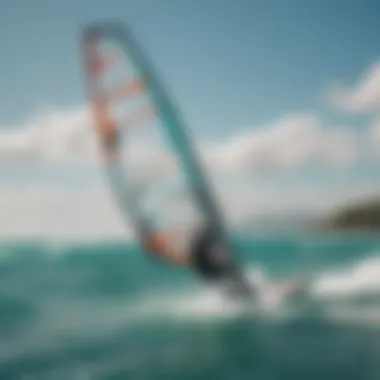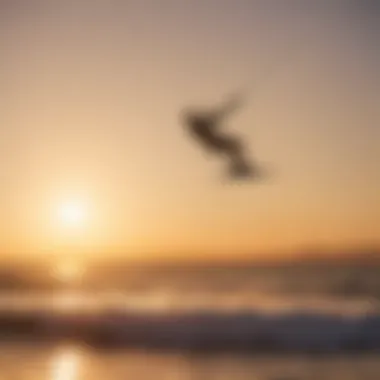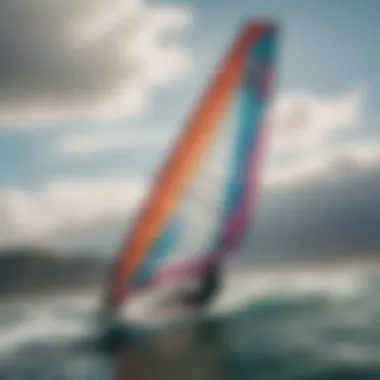Unveiling the Thrilling World of Windsurfing and Kiteboarding: An Extensive Guide


Equipment Reviews
When delving into the captivating realms of windsurfing and kiteboarding, understanding the nuances of the gear is paramount. In the world of kites, a spectrum of models awaits, each boasting distinctive features that cater to varying styles and preferences. From delta to bow kites, the shapes and sizes play a pivotal role in performance, affecting factors like power delivery and wind range. Examining the materials used, be it ripstop nylon or innovative canopy designs, sheds light on durability and responsiveness. Additionally, brands like Naish, Cabrinha, and Duotone vie for riders' attention, each with its signature aesthetics and technological advancements.
The boards utilized in kiteboarding come in diverse forms, each tailored to specific riding styles and conditions. Twintip boards, favored for their versatility and ease of use, are ideal for freestyle tricks and jumps, thanks to their bidirectional design. In contrast, directional boards excel in wave riding scenarios, offering superior maneuverability and control on the surf. The design intricacies, such as rocker profiles, concaves, and fins, significantly impact the board's performance, ensuring an exhilarating experience on the water. Construction materials like carbon fiber or wood cores further enhance durability and responsiveness, culminating in a seamless interaction between the rider and the board.
Essential accessories augment the safety and comfort of a kiteboarder, underscoring the importance of preparation and readiness on the water. Harnesses, in their various forms like waist or seat harnesses, provide crucial support and control, enabling riders to focus on technique and enjoyment. Lines of different lengths dictate the kite's responsiveness and power delivery, offering riders flexibility in adapting to changing wind conditions. Pumps serve as the lifeline for inflating kites swiftly, minimizing downtime and maximizing water time. Safety gear, including helmets, impact vests, and release systems, form a critical part of a kiteboarder's arsenal, mitigating risks and ensuring a safe and enjoyable session on the waves.
Introduction to Windsurfing and Kiteboarding
In this section, we begin our exploration of the captivating world of windsurfing and kiteboarding. These water sports have gained immense popularity among enthusiasts globally, offering a thrilling experience that blends skill and excitement on the water. Windsurfing combines elements of sailing and surfing, utilizing a board with a sail to harness wind power for movement. Kiteboarding, on the other hand, involves maneuvering on a board while being propelled by a kite, providing a unique adrenaline rush unlike any other water sport. Both activities require a blend of physical prowess, technical skill, and an appreciation for the forces of nature that drive them.
The Origins of Windsurfing and Kiteboarding
Historical Evolution of Windsurfing
The historical evolution of windsurfing traces back to the 1960s when pioneers sought innovative ways to combine elements of sailing and surfing into a single sport. The iconic Windsurfer design revolutionized water sports by introducing a board with a mast and sail, allowing riders to navigate the water with enhanced freedom and agility. This pivotal development laid the foundation for modern windsurfing, shaping the equipment, techniques, and competitive landscape we see today.
Rise of Kiteboarding as an Extreme Sport
Kiteboarding emerged as an extreme sport in the late 1990s, blending elements of windsurfing, wakeboarding, and paragliding into a dynamic and adrenaline-pumping experience. The utilization of specialized kites for propulsion revolutionized water sports, enabling riders to achieve high speeds, impressive aerial maneuvers, and a strong connection with natural elements. The rise of kiteboarding heralded a new era of water sports, attracting thrill-seekers looking to push boundaries and master the elements.
Distinguishing Between Windsurfing and Kiteboarding
Equipment Variances
Distinguishing between windsurfing and kiteboarding lies in their equipment variances. Windsurfing requires a board with an attached mast and sail, along with a boom for sail control. Kiteboarding, conversely, utilizes a board similar to wakeboarding, coupled with a controllable kite connected by lines to a harness worn by the rider. Each set of equipment offers unique advantages and challenges, catering to different riding styles and preferences of enthusiasts.
Technique Contrasts
The techniques employed in windsurfing and kiteboarding differ significantly, influencing the riding experience and skill requirements. Windsurfing relies on steering the sail to catch the wind, directing the board's movement through tacking and jibing maneuvers. In contrast, kiteboarding involves utilizing the kite to generate power and control speed, incorporating jumps, loops, and freestyle tricks that demand precise coordination and agility. Mastery of these distinct techniques is essential for navigating the water with finesse and style.
Appeal and Popularity of Windsurfing and Kiteboarding
Thrill of Adrenaline
One of the key appeals of windsurfing and kiteboarding is the adrenaline rush that comes from harnessing the power of wind and waves. Riders experience an intense thrill as they glide across the water, mastering speed and maneuvers that elevate heart rates and offer a sense of accomplishment. The adrenaline-fueled nature of these sports attracts adventurous individuals seeking excitement and a challenge that pushes personal boundaries.


Connection with Nature
Beyond the thrill of adrenaline, windsurfing and kiteboarding offer a profound connection with nature that is unmatched by other water sports. Riders become attuned to the wind patterns, wave dynamics, and natural elements that shape their experience on the water. This intimate interaction with the environment fosters a deep appreciation for the outdoors, promoting sustainability, and environmental stewardship among enthusiasts. The profound connection with nature experienced through windsurfing and kiteboarding adds a spiritual dimension to the exhilarating sport, enriching both body and soul.
Essential Equipment for Windsurfing and Kiteboarding
In the world of windsurfing and kiteboarding, having the right equipment is paramount for a successful and enjoyable experience on the water. The equipment used in these water sports not only enhances performance but also ensures safety. Understanding the essential gear required for windsurfing and kiteboarding is crucial for beginners and seasoned riders alike. From boards and sails to kites and harnesses, each piece of equipment plays a unique role in maximizing your time on the waves.
Windsurfing Gear
Board Types and Features
Board types and features are essential considerations when it comes to windsurfing. The type of board you choose can greatly impact your maneuverability and stability on the water. Windsurfing boards come in various shapes and sizes, each designed for specific conditions and skill levels. Beginners may opt for larger, more stable boards that offer better stability, while advanced riders may prefer smaller, more maneuverable boards for aggressive turns and tricks. Features such as hull shape, volume, and foot straps all contribute to the performance of the board, making it vital to select the right one based on your expertise and the conditions you will be riding in.
Sail Varieties and Sizing
Sails are another critical component of windsurfing gear, as they harness the power of the wind to propel you across the water. Sail size is determined by various factors, including wind conditions, rider weight, and skill level. Larger sails provide more power and are suitable for light winds, while smaller sails offer better control in strong winds. Different sail varieties, such as cambered and rotational sails, cater to different riding styles and preferences. Understanding sail sizing and types is key to optimizing your windsurfing experience and enhancing your performance on the water.
Kiteboarding Essentials
Kite Designs and Control Systems
Kite designs and control systems are fundamental aspects of kiteboarding gear that directly impact your riding experience. Kites come in different designs, such as delta, hybrid, and bow kites, each offering unique benefits in terms of wind range, stability, and maneuverability. The control system, including the bar and lines, allows riders to steer and control the kite effectively. Knowing how to operate the control bar, depower the kite, and perform quick releases is essential for safe and efficient kiteboarding sessions. Understanding kite designs and control systems ensures that you can select the right kite for your riding style and skill level, enhancing your performance on the water.
Harness and Bar Configurations
Harnesses and bar configurations play a crucial role in kiteboarding, providing riders with stability, control, and comfort during their sessions. Harness options include waist harnesses, seat harnesses, and vest harnesses, each catering to different preferences and riding styles. The harness distributes the kite's pull, reducing strain on the rider's arms and allowing for longer and more comfortable sessions. Bar configurations, such as adjustable bar lengths and chicken loop systems, offer riders customization options to suit their needs and preferences. Choosing the right harness and bar setup is essential for enhancing control, maneuverability, and overall enjoyment while kiteboarding.
Mastering the Techniques
In this comprehensive guide exploring the world of windsurfing and kiteboarding, mastering the techniques holds paramount significance. Understanding the intricacies of windsurfing maneuvers and kiteboarding tricks is essential for enthusiasts to progress and excel in these exhilarating water sports. By delving into the fundamental concepts and advanced techniques, riders can refine their skills and enhance their overall performance on the water.
Fundamentals of Windsurfing Maneuvers
Tacking and Jibing
Tacking and jibing, the fundamental windsurfing maneuvers, are pivotal for navigating the wind and changing directions effectively on the water. The key characteristic of tacking involves turning the board into the wind to change direction, while jibing entails turning the board away from the wind. These maneuvers are essential for windsurfers to maneuver efficiently against the wind's force and make controlled turns during their rides. Mastering tacking and jibing allows riders to enhance their agility and control while harnessing the wind's power effectively, making them popular choices for riders seeking to elevate their windsurfing skills.
Harnessing the Wind Power


Another crucial aspect of windsurfing is harnessing the wind power to propel the board forward and control its speed and direction. By skillfully adjusting the sail angle and positioning relative to the wind, windsurfers can leverage the wind's force to maneuver the board with precision and grace. Harnessing the wind power enables riders to perform various maneuvers, such as accelerating, decelerating, and navigating through turbulent waters. While this technique requires practice and finesse, its advantages lie in enhancing the rider's speed and responsiveness, allowing for dynamic and exhilarating windsurfing experiences.
Advanced Kiteboarding Tricks
Jumping and Airborne Maneuvers
One of the exhilarating aspects of kiteboarding is executing jumping and airborne maneuvers, showcasing the rider's skill and daring on the water. Jumping involves launching off the water's surface and performing breathtaking mid-air maneuvers before landing smoothly back onto the water. This advanced technique requires precise control and timing, as riders must harness the kite's power to ascend into the air and execute complex tricks with finesse. The unique feature of jumping lies in the adrenaline rush and exhilaration it provides, making it a popular choice for thrill-seeking kiteboarders looking to push their limits and showcase their aerial prowess.
Unhooked Riding Techniques
Unhooked riding techniques in kiteboarding entail riding without being attached to the control bar, allowing riders greater freedom of movement and versatility in executing maneuvers. By unhooking from the control bar, kiteboarders can perform a range of tricks and rotations with increased mobility and style. This technique's unique feature lies in the fluidity and creativity it offers, enabling riders to explore diverse trick possibilities and express their individuality on the water. While unhooked riding enhances the rider's flexibility and maneuverability, it also presents challenges in maintaining control and balance, requiring advanced skills and precision to master effectively.
Safety and Etiquette Guidelines
In the realm of windsurfing and kiteboarding, mastering safety and etiquette guidelines is paramount to ensuring a thrilling and secure experience on the water. Understanding and adhering to these guidelines not only safeguard the rider but also promote harmony and respect among fellow enthusiasts. Safety protocols and proper conduct not only enhance the individual's own experience but contribute to an overall positive environment for all participants.
Windsurfing Safety Measures
When it comes to windsurfing safety, one of the key elements to consider is weather awareness. Being attuned to changing weather conditions is crucial for the safety of the rider. Understanding wind patterns, potential storms, and other weather-related factors can help prevent accidents and ensure a smooth sailing experience. Emphasizing the importance of weather awareness in this article sheds light on its significance in mitigating risks and enhancing the overall windsurfing journey.
Rescue protocols play a pivotal role in windsurfing safety by providing a structured approach to handle emergencies effectively. Knowing rescue procedures, including how to assist others in distress and seek help when needed, can make a difference in critical situations. Highlighting the significance of rescue protocols in this context underscores the need for preparedness and swift action in challenging scenarios.
Kiteboarding Etiquette
In the world of kiteboarding, observing proper etiquette is essential for fostering a safe and enjoyable environment for all participants. Understanding and following right of way rules is fundamental in avoiding collisions and ensuring a smooth flow of kiteboarding sessions. Respecting the priority of others in various situations contributes to a harmonious and safe kiteboarding experience. Discussing right of way rules in this article highlights their importance in promoting safety and order within the kiteboarding community.
Launching and landing procedures in kiteboarding are critical aspects that require attention to detail and caution. Properly executing these procedures not only safeguards the rider but also protects equipment and prevents accidents. Detailing the correct methods for launching and landing kites in this article emphasizes their role in facilitating safe and efficient kiteboarding sessions. Understanding and following these procedures enhance safety measures and contribute to a seamless kiteboarding experience.
Exploring Top Windsurfing and Kiteboarding Destinations
In this section of the comprehensive guide, we delve into the vital aspect of exploring top windsurfing and kiteboarding destinations. The significance of selecting the right destination is crucial for enthusiasts to experience optimal conditions and challenges suited to their skill level. Top destinations offer unique characteristics, benefits, and considerations that cater to the diverse needs of windsurfers and kiteboarders.
Wind and Wave Paradise: Maui, Hawaii
Conditions and Challenges
Venturing into the renowned Wind and Wave Paradise of Maui, Hawaii, unveils a plethora of unique conditions and challenges that entice water sports enthusiasts worldwide. The specific aspect of conditions and challenges in Maui revolves around the consistent trade winds and varied wave heights, providing an ideal setting for both windsurfing and kiteboarding. Surfers and kiters alike cherish the reliable wind patterns and the thrill of riding the waves, making Maui a prime choice for those seeking an adrenaline-packed experience on the water.
Local Culture


The local culture in Maui, Hawaii, plays a significant role in enhancing the overall windsurfing and kiteboarding experience. From the warm hospitality of the Hawaiian locals to the rich traditions deeply rooted in water sports, visitors are immersed in a vibrant community that embraces the spirit of adventure and respect for nature. The unique blend of indigenous Hawaiian customs and modern water sports practices creates a welcoming environment for riders of all levels, adding a cultural dimension to the exhilarating activities offered in this stunning destination.
Turquoise Waters of Tarifa, Spain
Mediterranean Charm
Exploring the turquoise waters of Tarifa, Spain, unveils the Mediterranean charm that sets this destination apart as a must-visit hub for windsurfers and kiteboarders. The key characteristic of Tarifa lies in its stunning natural beauty coupled with consistently favorable wind conditions that attract water sports enthusiasts from around the globe. Riders revel in the warm Mediterranean climate and crystal-clear waters, making Tarifa a popular choice for those seeking a sublime experience in a picturesque setting.
Spot Guide
The spot guide of Tarifa, Spain, serves as a compass for riders navigating the coastal paradise, offering insights into the best locations, wind directions, and wave conditions. This detailed guide assists windsurfers and kiteboarders in maximizing their time on the water, from beginner-friendly spots to adrenaline-inducing wave-riding zones. With its comprehensive spot guide, Tarifa ensures that riders of all skill levels can make the most of their aquatic adventures in this idyllic Mediterranean gem.
Thrills in the Outer Banks, North Carolina
East Coast Gem
The Outer Banks, North Carolina, emerges as an East Coast gem for windsurfing and kiteboarding, boasting a unique charm that caters to riders seeking thrilling experiences along the Atlantic seaboard. The key characteristic of this destination rests in its dynamic wind patterns and diverse water conditions, providing ample opportunities for exploration and excitement. With a laid-back coastal atmosphere and vast stretches of open water, the Outer Banks stand out as a hidden gem for riders looking to escape the crowds and savor the essence of East Coast water sports.
Best Times to Visit
Determining the best times to visit the Outer Banks is crucial for optimizing the windsurfing and kiteboarding experience in this coastal haven. The particular aspect of timing impacts the overall enjoyment of riders, with peak seasons offering ideal wind speeds and weather conditions for exhilarating sessions on the water. Understanding the seasonal nuances and fluctuations in wind patterns ensures that enthusiasts can make the most of their visits to the Outer Banks, whether seeking challenging maneuvers or tranquil rides along the scenic coastline.
Embracing the Windsurfing and Kiteboarding Lifestyle
In the world of windsurfing and kiteboarding, embracing the lifestyle goes beyond just a sport; it becomes a way of life for enthusiasts. The lifestyle encapsulates a sense of freedom, adrenaline, and connection with nature that is unparalleled. Participants in these water sports often find themselves deeply ingrained in a tight-knit community where bonds are strengthened through shared experiences on the waves. The lifestyle accentuates a blend of physical activity, mental agility, and a deep appreciation for the elements, making it a multifaceted pursuit that appeals to those seeking adventure and a break from conventional routines. As riders gear up to embrace the windsurfing and kiteboarding lifestyle, they not only commit to mastering the skills of the sport but also engaging with like-minded individuals, fostering a sense of camaraderie and support that extends beyond the water.
Community Bonds and Events
Competitions
Competitions stand as pinnacle events in the windsurfing and kiteboarding community, showcasing top-tier skills and the competitive spirit among riders. These events attract participants from across the globe, offering a platform for riders to challenge themselves, push boundaries, and elevate their performance levels. The competitive nature of these events fosters growth, camaraderie, and a spirit of sportsmanship within the community. Riders thrive on the adrenaline rush of competing against peers, honing their abilities, and striving for excellence on the waves. While competitions bring out the best in riders, they also serve as a stage for sharing techniques, learning from fellow athletes, and celebrating the sport's dynamic culture as a whole.
Festivals
Festivals add a celebratory flair to the windsurfing and kiteboarding scene, creating vibrant hubs of energy and excitement for participants and spectators alike. These festive gatherings blend music, food, and cultural elements with the thrill of water sports, creating a unique atmosphere that captures the essence of the lifestyle. Participants immerse themselves in a carnival of activities, enjoying beach parties, product showcases, and engaging workshops that add depth to their experience. Festivals not only serve as social gatherings but also as opportunities to learn, connect, and appreciate the diversity of the sport. By bringing together individuals with a shared passion for windsurfing and kiteboarding, festivals foster a sense of unity, creativity, and exploration in a lively and inviting setting.
Gear Reviews and Recommendations
Latest Innovations
Innovation drives progress in the windsurfing and kiteboarding realm, paving the way for cutting-edge equipment that enhances performance and safety on the water. The latest innovations in gear focus on precision engineering, advanced materials, and design improvements that cater to the evolving needs of riders. From state-of-the-art sails with aerodynamic features to lightweight boards with enhanced stability, these innovations elevate the riding experience to new heights. Riders benefit from improved control, speed, and response times, amplifying their capabilities and confidence on the water. Embracing the latest gear innovations allows riders to stay ahead of the curve, adapt to changing conditions, and explore new horizons in windsurfing and kiteboarding.
Expert Picks
Expert picks offer invaluable insights for riders seeking to optimize their gear selection and performance outcomes on the water. These recommendations come from seasoned professionals, instructors, and gear specialists who have extensive experience in the sport and understand the nuances of equipment functionality. Expert picks cover a range of gear categories, including boards, sails, kites, harnesses, and safety accessories, providing riders with tailored guidance based on their skill level, preferences, and riding style. By following expert recommendations, riders can make informed decisions, secure high-quality gear, and maximize their potential on the waves. Expert picks not only streamline the gear selection process but also empower riders to make strategic choices that align with their goals, enhancing their overall windsurfing and kiteboarding experience.







